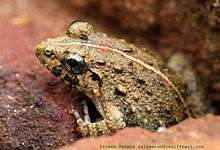Fejervarya limnocharis
| Fejervarya limnocharis | |
|---|---|
 | |
| A cricket frog from South India | |
| Scientific classification | |
| Kingdom: | Animalia |
| Phylum: | Chordata |
| Class: | Amphibia |
| Order: | Anura |
| Family: | Dicroglossidae |
| Subfamily: | Dicroglossinae |
| Genus: | Fejervarya |
| Species: | F. limnocharis |
| Binomial name | |
| Fejervarya limnocharis (Gravenhorst, 1829) | |
| Synonyms | |
|
Rana limnocharis Gravenhorst, 1829 | |
Fejervarya limnocharis is a species of frog found widely distributed in South Asia. It is known under many common names, including Indian cricket frog, Boie's wart frog, rice field frog, and Asian grass frog. Molecular studies of the species complex suggest that there may be multiple species involved.[2]
Description
The following description is from Boulenger:[3]
- Very closely allied to Rana tigrina, from which it differs in its smaller size, half-webbed toes, slight development of the fringe on the fifth toe, and usually in the presence of a small outer metatarsal tubercle. The length and shape of the snout, the size of the inner metatarsal tubercle, and the relative length of the hind limbs and of the fourth toe vary to an extraordinary degree. The tibio-tarsal articulation usually reaches the eye, or between the latter and the end of the snout; but in some specimens (var. brevipalmata, from Pegu and S. India) it reaches considerably beyond the end of the snout, and the foot measures two thirds the distance between the end of the snout and the vent Greenish or olive, with darker spots; a light vertebral line or band frequently present; sometimes a light line along the inner side of the leg; sides of thighs black-marbled; throat of male usually with two large black blotches, sometimes connected and forming a 'M'.[3]
This species measures 2–5 cm (0.8–2.0 in) from snout to vent.
The species forms a complex with several genetic variants that may represent multiple species.[4][5]

Distribution
A widely distributed species, extending from China and Southern Japan, throughout India, Sri Lanka, and Burma to the Malay Peninsula and Archipelago. In the Himalayas (Sikkim) it occurs up to 7,000 ft (2,100 m). Stoliczka observed that it usually does not hesitate to take to the sea or brackish water.[3] In Pakistan it occurs in the Indus drainage from the delta north at least to Rawalpindi.[6]
According to the Amphibian Species of the World, records outside Indonesia, Malaysia, Thailand, Burma, Cambodia, Laos, and Vietnam are almost certainly representing other species.[2]
References
- ↑ Peter Paul van Dijk; Djoko Iskandar; Robert Inger; Michael Wai Neng Lau; Zhao Ermi; Geng Baorong; Sushil Dutta; Kelum Manamendra-Arachchi; Anslem de Silva; Sabitry Bordoloi; et al. (2009). "Fejervarya limnocharis". IUCN Red List of Threatened Species. Version 2013.1. International Union for Conservation of Nature. Retrieved 22 July 2013.
- 1 2 Frost, Darrel R. (2013). "Fejervarya limnocharis (Gravenhorst, 1829)". Amphibian Species of the World 5.6, an Online Reference. American Museum of Natural History. Retrieved 22 July 2013.
- 1 2 3 Boulenger, G. A. (1890) Fauna of British India. Reptilia and Batrachia.
- ↑ M Kotaki, A Kurabayashi, M Matsui, W Khonsue, TH Djong, M Tandon, M Sumida (2008) Genetic Divergences and Phylogenetic Relationships Among the Fejervarya limnocharis Complex in Thailand and Neighboring Countries Revealed by Mitochondrial and Nuclear Genes. Zoolog Sci 25: 381-90.
- ↑ Mohammed Mafizul Islam, Md Mukhlesur Rahman Khan, Djong Hon Tjong, Mohammad Shafiqul Alam, Masayuki Sumida (2008) Genetic Differentiation of the Fejervarya limnocharis Complex from Bangladesh and Other Asian Countries Elucidated by Allozyme Analyses. Zoolog Sci. 25(3):261-72
- ↑ Minton, S. A. Jr 1966 A contribution to the herpetology of West Pakistan. Bull. Amer. Mus. Nat. Hist. 134(2)
External links
| Wikimedia Commons has media related to Fejervarya limnocharis. |
